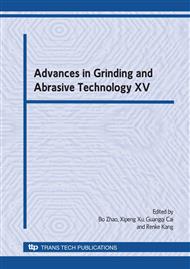p.223
p.228
p.234
p.238
p.243
p.248
p.253
p.259
p.264
Drilling Force of SiC Particle Reinforced Aluminum-Matrix Composites with Ultrasonic Vibration
Abstract:
In recent years, particle reinforced metal matrix composites (PRMMCs)has been widely applied because of its excellent mechanical performances. But the machining is very difficult due to the rigidity of reinforced phase in it, thus the popularization of PRMMCs is restricted much. Here, a method of ultrasonic vibration drilling is presented to the hole-making of Aluminum-matrix composites based on cutting force analysis between common and vibration machining. In virtue of the self-developed ultrasonic drilling equipment, experiments of common and ultrasonic vibration drilling are performed on SiC particle reinforced Aluminum-matrix composites with different content of SiC by using two types of tungsten carbide twist drill. Since the tool life can be represented directly by drilling force, especially the torque, the study of drilling force is very important for the surface roughness, the design and life of drill. Drilling force and its variation in the machining process are analyzed by comparison of common and vibration drilling. It shows that the eviction of drilling chips can be meliorated to some extent, and the drilling torque can be reduced about 30% during the ultrasonic vibration drilling process.
Info:
Periodical:
Pages:
243-247
Citation:
Online since:
September 2009
Authors:
Keywords:
Price:
Сopyright:
© 2009 Trans Tech Publications Ltd. All Rights Reserved
Share:
Citation:


